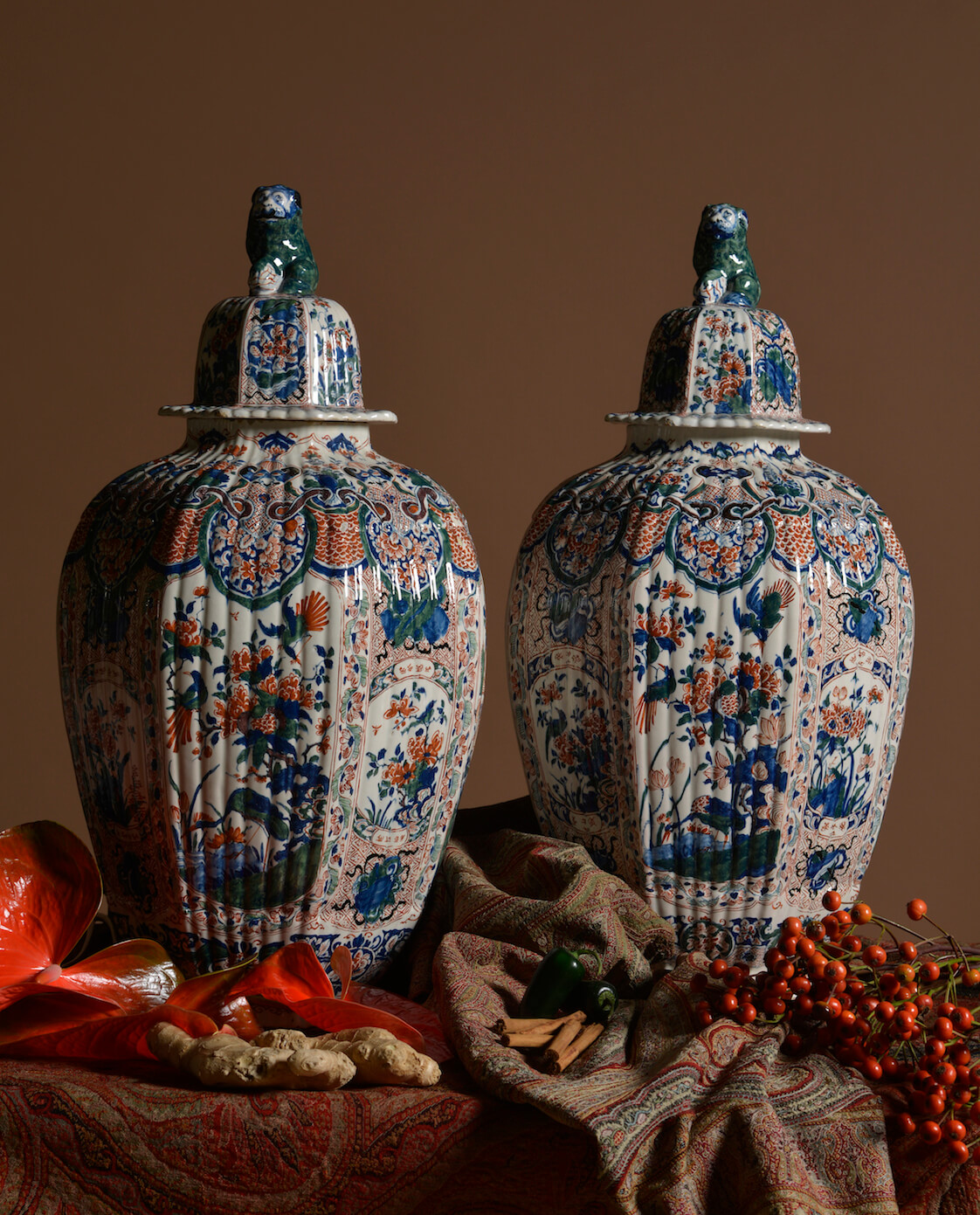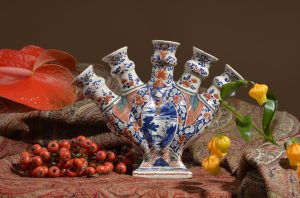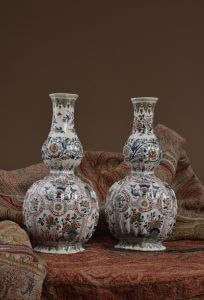
The Splendor of the Orient
During the mid-nineteenth century, there was not only a fascination for the Orient and its exotic wares, but also a rediscovery of the Golden Age of Delftware, and European collectors and intellectuals developed a keen appreciation for the Dutch earthenware. This marked the first serious attempt to assemble, classify and study Delftware. The names given to the shapes and decorations were assigned by the first connoisseurs of Delftware, and thus reflect their contemporary world views, having little to do with the original background of the design itself.[1]
Delftware objects made between 1700 and 1720 were among the highly coveted objects of the nineteenth century. The delicate grand feu decoration of these Delftware objects were given the descriptive title ‘cashmere’ for their likeness in color, and exotic, dense motifs to the fine woolen shawls that were imported from India and worn by high class European ladies. The earthenware of this category has a reeded surface with a color scheme of blue, red and green. Occasionally, the pieces were decorated with manganese and yellow.
 Although the Delft pieces were named after the fashionable textiles, the Delft potters were in fact inspired by the Chinese Famille Verte porcelain wares of the Kangxi period (1662-1722), which arrived in Europe at the end of the seventeenth century. The Chinese designs inspired Delft potters to expand upon the grand feu technique; new shades appeared and the colors became more intense due to an additional layer of transparent lead glaze applied over the surface.[2] The classical blue and red palette was complemented by several shades of green, which were derived from the Famille Verte wares. Yellow was sometimes used for extra emphasis on pieces, especially in the decoration of large garniture sets. Black was also used in Famille Verte designs, but was seldom applied on Delftware. The few pieces of Delftware with black glazed decoration are almost always on a non-reeded ground and typically reserved for exceptional forms. Because black was a difficult color to apply to earthenware, some painters used a dark manganese.[3]
Although the Delft pieces were named after the fashionable textiles, the Delft potters were in fact inspired by the Chinese Famille Verte porcelain wares of the Kangxi period (1662-1722), which arrived in Europe at the end of the seventeenth century. The Chinese designs inspired Delft potters to expand upon the grand feu technique; new shades appeared and the colors became more intense due to an additional layer of transparent lead glaze applied over the surface.[2] The classical blue and red palette was complemented by several shades of green, which were derived from the Famille Verte wares. Yellow was sometimes used for extra emphasis on pieces, especially in the decoration of large garniture sets. Black was also used in Famille Verte designs, but was seldom applied on Delftware. The few pieces of Delftware with black glazed decoration are almost always on a non-reeded ground and typically reserved for exceptional forms. Because black was a difficult color to apply to earthenware, some painters used a dark manganese.[3]
Delftware painters followed a similar decorative scheme on the cashmere wares as the Chinese: rocky landscapes, exotic birds in flight, or perched on branches of chrysanthemums, fluttering insects, and mythical beasts. These subjects were sometimes combined with Chinese symbols, which as far as we know were often interpreted freely and therefore lacked their original meaning. Delft potters often appropriated Chinese imagery and symbols, which appealed to European clients seeking objects with Oriental flair.
 Delftware potters also looked beyond China for further inspiration in designing cashmere pieces. One such design source was the French baroque style that reigned during the age of King Louis XIV. The artistic imprint of Versailles was reflected in the Dutch decorative arts, particularly in the cashmere palette pieces. After the revocation of the Edict of Nantes in 1685, many French architects and decorators fled from the threat of Protestant persecution. Many prolific figures settled in the Netherlands, including the renowned designer and engraver Daniel Marot. He became the official architect of William III, Prince of Orange, who entrusted him with the decoration of his residence, Palace Het Loo. In his palace designs, Marot exported the style of Jean Berain, one of Louis XIV’s official designers at the Manufacture des Gobelins.
Delftware potters also looked beyond China for further inspiration in designing cashmere pieces. One such design source was the French baroque style that reigned during the age of King Louis XIV. The artistic imprint of Versailles was reflected in the Dutch decorative arts, particularly in the cashmere palette pieces. After the revocation of the Edict of Nantes in 1685, many French architects and decorators fled from the threat of Protestant persecution. Many prolific figures settled in the Netherlands, including the renowned designer and engraver Daniel Marot. He became the official architect of William III, Prince of Orange, who entrusted him with the decoration of his residence, Palace Het Loo. In his palace designs, Marot exported the style of Jean Berain, one of Louis XIV’s official designers at the Manufacture des Gobelins.
The Asian scenes were placed amidst friezes of lace lambrequin and sometimes a dizzy abundance of vegetation with extraordinary flights of fancy. There are many pieces on which the white ground is almost completely submerged by the decoration. The taste for luxuriant decoration no doubt encouraged the painters to use a bright, if limited, palette, which gave the pieces great richness.[4] While the cashmere designs were taken from China and various European decorative sources, the shapes were derived from European silverware models. For Delft potters, it required a great amount of knowledge and skill to transform shapes originally wrought in metal into earthenware. The reeded surfaces of the cashmere pieces were a particularly expensive and delicate process.[5]
The cashmere palette enjoyed a brief, yet widespread success during the first half of the eighteenth century. The production of these elaborate reeded pieces was probably too expensive, and the development of the petit feu colors gave the Delft potters new experimental opportunities. Nevertheless, the cashmere style remains one of the greatest achievements of the Dutch painter-potters, perfectly embodying the splendor of the Orient.
[1] J.D. van Dam, Delffse Porceleyne, Dutch Delftware 1620-1850, Zwolle/Amsterdam (Rijksmuseum), 2004, p. 111.
[2] C. Lahaussois, Faïences de Delft. La collection du Musée des Arts Décoratifs, Musée des Arts Décoratifs, Paris 1994, p. 150.
[3] C. Lahaussois (ed.), Delfts Aardewerk, Amsterdam 2008, p. 128.
[4] H.-P. Fourest, Delftware, London 1980, p. 74.
[5] Lahaussois, 2008 (note 3), p. 128.



